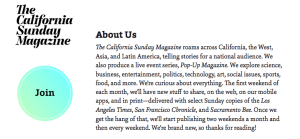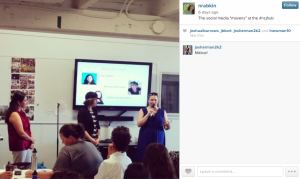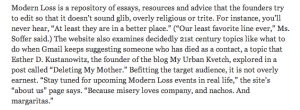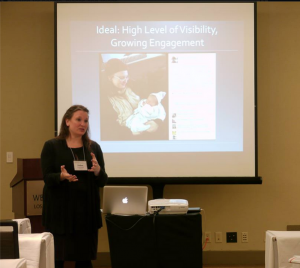
Hashtags & Haystacks – Social Media, “Ranch-Style”
0What’s “Ranch-Style” Social Media? Good question…well, it has little to do with the creamy dressing that people use to dip hot wings and occasionally vegetables into, and everything to do with the location of my last social media training .
I was honored to have been invited by the folks at See3 Communications to be part of the social media boot camp they were conducting for the Leichtag Foundation, a foundation whose mission it is to honor the legacy of Lee and Toni Leichtag through igniting and inspiring vibrant Jewish life, advancing self-sufficiency and stimulating social entrepreneurship in coastal North San Diego County and Jerusalem. The event was held Monday, September 15, at the Leichtag-run ranch in Encinitas (near San Diego), where a number of social entrepreneurship programs and Jewish organizations also were headquartered under an initiative called the North County Jewish Hub. (You can view tweets, photos & vines from the day at #NCJHub.)
My presentation on Twitter provided some best practices, as well as some examples of what constitutes good engagement (like the @midnight #HashtagWars) and what constitutes a Twitter #fail (for instance, the recent DiGiorno’s #WhyIStayed snafu).
The media session provided lots of hints about how to approach – and most importantly, develop ongoing relationships with – members of the media, to maximize your chances of getting coverage for an event or organization.

It’s Been A While, But I’m Back…
0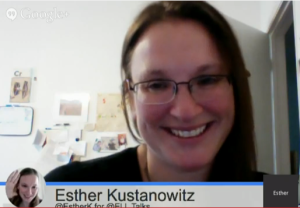 Thanks for your patience while we worked out some technical challenges with EstherK.com – I’m looking forward to bringing you more writing, advice and food for thought in this space over the next few months, and hope you’ll be here to think, learn and laugh with me. Until the fresh content is fully baked, I wanted to share these two videos with you.
Thanks for your patience while we worked out some technical challenges with EstherK.com – I’m looking forward to bringing you more writing, advice and food for thought in this space over the next few months, and hope you’ll be here to think, learn and laugh with me. Until the fresh content is fully baked, I wanted to share these two videos with you.
I’ve started working as freelance community manager for ELI Talks, a program designed to bring TED-style talks and weekly on-air conversations to people who want to explore Jewish engagement, literacy and identity. Most of the time, I’m behind the camera, live-tweeting the weekly conversations (you can see past editions at the ELI Talks website under the section for ELI Talks on Air). But my first run was as an intervieweee – I spoke about my writing on everything from Jewish singles to life after loss; and my next one was as an interviewer, as I spoke to the guys behind the Jewish video site Shmideo. (The links in the previous sentence will take you to MyUrbanKvetch, for the minute-by-minute breakdown, in case you’d like to see a part of the video without sitting down to watch the entire thing. :))
More content to come – looking forward to sharing with you in this space soon! (And a happy Jewish new year to those of you who are celebrating…)

March Madness: Recent Clips
0This week was simply mad – a personal essay in the JTA (commonly known as the AP of the Jewish world) about loss, focusing on a ring that was my mother’s; I attended my lovely and moving good-bye party at work; a new part-time job came together which enables me to shift into new styles of writing (more to come on that later); and over this weekend, was mentioned in an article in the New York Times about the Modern Loss site, to which I had contributed a piece titled “Deleting My Mother.” (As an extra bonus moment of glee, the Times referred to me as “founder of the blog My Urban Kvetch,” a mention I never would have imagined when I founded it ten years ago.)
Earlier in March, I read a piece about improv inspiring creativity at Jewish nonprofits, and decided to take it one step further with this piece, “Yes-And’ing Our Way to Organizational Progress.”
This past weekend was also the Jewish holiday of Purim, which is typically marked by celebration and comedic performances, including something called a “Purim shpiel” – generally this highlights the story of Purim in some way, but the spiritual community known as IKAR treats the “shpiel” time as an opportunity to lampoon the community itself. This is my second year on the writing team for the Shpiel, and one of my two contributions was a parody of pharmaceutical commercials, but treating IKAR itself as the drug. (The other one, a Yiddish-inflected parody of “Roar,” by Katy Perry, isn’t posted yet.) There’s a lot of inside comedy, but I think it still plays to others. Check it out!

Cupid’s Clips: This Week’s Articles
0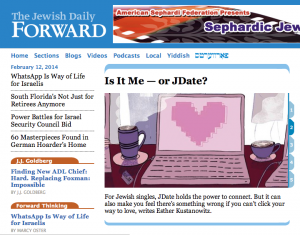 While Valentine’s Day week isn’t always a week of romance and celebration for everyone, this year, Cupid brought me two new clips to share.
While Valentine’s Day week isn’t always a week of romance and celebration for everyone, this year, Cupid brought me two new clips to share.
Last weekend in the print edition and Tuesday online, the Forward published my piece “The Jewish Lonely Hearts Who Meet Online” – about online dating sites, the blame game that singles play with each other, and how we all could take a higher road when it comes to interacting online.
Then on Facebook, we launched some midweek discussions about JDate’s advertising, when that niche dating service launched its new ad campaigns, making some laugh and others cringe. With slogans taking a pot shot at Match.com (“6000 years of persecution and now you’re joining Match.com?”) and appealing to those who are waiting to “find someone who shares your love of gefilte fish,” the slogans run from the stereotypical to the unoriginal, playing to the broadest strokes of public awareness of what defines a Jew, and what those Jews are looking for when they’re looking for love online. (You can read the NYTimes article about this new campaign here.)
In a sad note this week, but relevant to Valentine’s Day as an opportunity to share things we love with people we love, the world lost famous comedian Sid Caesar. The Jewish Journal asked me to write something – since I love writing about entertainment, TV and comedy, and did feel a bit personally connected to Caesar (even though we had never met), I wrote this piece – “My Friend’s Seder With Sid: Remembering Sid Caesar,” now featured in the Jewish Journal’s Religion section – about how virtual connections can become real, with people acting as emissaries and interceding to create real-life connections. The story contains some of my friend’s personal reflections of her time with Sid over the last year, and reminds us of how much laughter he gave the world. May his memory and his work continue to be an inspiration to those of us who dabble in or appreciate comedy. 🙂

Social Media…On the Richter Scale
0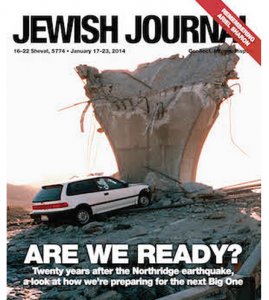 Those of us who live in Los Angeles – or anywhere where earthquakes are part of our regular lives – know today’s truth: if it wasn’t confirmed on Twitter and Facebook, it wasn’t really an earthquake. But in their recent coverage of the 20th anniversary of the famous Northridge Earthquake, The Jewish Journal asked me to weigh in on how social media is used during a national disaster of any sort.
Those of us who live in Los Angeles – or anywhere where earthquakes are part of our regular lives – know today’s truth: if it wasn’t confirmed on Twitter and Facebook, it wasn’t really an earthquake. But in their recent coverage of the 20th anniversary of the famous Northridge Earthquake, The Jewish Journal asked me to weigh in on how social media is used during a national disaster of any sort.
After a robust discussion with the reporter about the challenges of relying on social media during an unnamed generic disaster – will there be internet connectivity? how about battery chargers? – we spoke about the social aspects of connection and feeling like you’re not alone. The experience of receiving a literal jolt, some of us home alone or sleeping, startles us into reality – reaching out to others, even to say “did you feel that?” is such an essential and reassuring part of human reconnection. I have found it personally reassuring to watch as people shared stories of where they were, the embarrassing or funny situations that emerged, or jokes about where the quake hit and why.
I’m quoted minimally, but you can read the entire story here.

Kicking off January With “Jewish Geography Goes Digital”
0Mid-January arrived, and with it, the RAVSAK/PARDES Jewish educators’ conference – titled “Moving the Needle,” the content contained inspiring speakers, informative panels, deep dives into practical subject matters and workshops designed to give educators a skills upgrade. I was honored to present “Jewish Geography Goes Digital” to an involved and inquisitive group of Jewish educators from across the country – the interactive skills session featured extensive dialogue with those in the room, facilitated sharing of experience using social media in an educational context, and the introduction of new tools and awareness of social media culture as a way to deepen relationships with constituents.
You can check out my presentation below (and additional presentations are available here). And remember, if you’re interested in a consultation on social media culture or tools, creative content strategy, or communications methods for the digital age, please be in touch and we can discuss the possibilities.

Video Workshop: “Leadership in the Digital Age”
0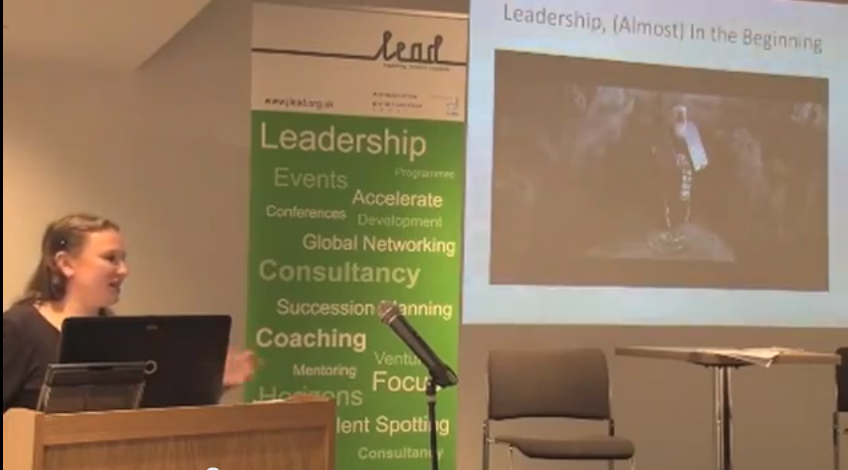 In May, I was invited to London to speak as part of the Jewish Leadership Council’s Lead Division’s newest initiative, Leading In which was created in response to the desire and need for more leadership skills training, expressed by alumni of Lead’s programmes as well as employers within the community. The JLC, in a blog post about the program, explained:
In May, I was invited to London to speak as part of the Jewish Leadership Council’s Lead Division’s newest initiative, Leading In which was created in response to the desire and need for more leadership skills training, expressed by alumni of Lead’s programmes as well as employers within the community. The JLC, in a blog post about the program, explained:
We believe that Jewish communal leaders need both a deep understanding and knowledge of the UK Jewish Community as well as a core range of leadership skills. Leading In consists of regular bi-monthly evening sessions, open to all who are in a leadership position in the community, both lay and professional. Each session will include a leadership skills based session (a choice of three with the option to participate in a fundraising series over several sessions), an opportunity to network and a masterclass with an inspirational, visionary leader.
The event, held at the London Jewish Museum, was attended by 60 lay and professional leaders from more than 30 Jewish communal organizations. Debbie Klein, chair of JW3 (the about-to-launch Jewish Community Centre), gave the opening keynote discussing leadership tips, and participants chose from workshops like, “Inside the mind of a leader” with Jeff Wolfin, “Fundraising” with Jeff Shear (the second in the series), and my session, “Leadership in the Digital Age: Conversing, Commenting and Creating Meaningful Relationships” (available in its entirety – 1 hour, 22 minutes – below.
“Leadership in the Digital Age” – Esther Kustanowitz, May 2013
Crash Course: 7 Tips Toward Strengthening Media Strategy
0
Over the years, I’ve had a number of people – at the office and in other areas of my life – ask for my advice on everything from PR to online content development and social media engagement. Most of them are just looking to glean some quick advice. So I thought it might be helpful to share a few pieces of advice about media strategy and PR. (A version of this post originally appeared on my blog, My Urban Kvetch.)
For a more comprehensive assessment of your current media strategy, or to work on particular elements of your media outreach, my consulting services are available at reasonable rates.
7 Tips Toward Strengthening Media Strategy
Whether you’re promoting an event that’s happened, or doing strategic outreach to bolster audience support, here are 7 basic elements to consider and tips to keep in mind:
1. Content: It’s cliched to say that content is king, but content is the storytelling core of your strategy. The content will create a connection – intellectual or emotional – to the work you do. Make your first sentence engaging, and give the reader something they can’t find anywhere else. This means not recycling the two paragraphs you’ve used in promoting the event or experience – it’s the story of that event or experience: why is it important, what is the backstory, which fascinating folks are involved…take the reader behind the scenes and give insider information that only attendees would have experienced. Begin with a killer sentence – a riveting question or a surprising quote – once you get people hooked, they’ll read on to find out more about what that first intriguing sentence means.
2. Length: Unless your Communications Department instructs you otherwise, I suggest a length of 400 words (maximum) for blog posts. Originally, about 400 words was be the maximum that would appear on a computer screen. Computers (and screen fonts) come in all sizes these days, but with the human attention span being fragmented, keeping it short and riveting is still a solid strategy. It also keeps you on track, making sure you use words and quotes that count, and helps increase the chance that people will read to the end.
3. Timing: If there’s a fast turnaround needed for a blog post the morning after an event, the best way to do it is to pre-write the bulk of it. This may sound dishonest, but PR people do it all the time – they create skeleton posts with all the stuff that you know ahead of time and is not going to change (the where, what, who, when and why). Then leave spaces for things that personalize the experience and paint “what really happened in the room” – quotes from speakers or attendees, surprises in terms of attendees or reactions or questions, details of the kinds of discussions and partnerships that ensued. The next day, fill in the blanks, massage the language so it doesn’t seem like a composite post, and you’ll have a compelling, authentic post, posted in record time. People will marvel at your efficiency, and you don’t have to reveal this secret to anyone. 🙂
4. Tone: Keep the “inside scoop” approach in mind when writing – so it’s not just “this happened, and it brought a lot of things together, and it was interesting,” but really capture the feel of who was there, how they were connecting with the speaker or presentation, and report some of the more interesting comments that go a little deeper and tell a better story than “this was a great event and I hope to attend another one soon.” The “insider info” approach is like crack to people who write and read blogs – even though it’s a calculated strategy, it’s still authentic and special, and that’s what people want. Depending on your organization’s tone, you may opt for more or less formal, but the voice should be factual, authoritative and relatable.
5. Images: Any photos accompanying online content should be dynamic. People sitting at tables is one of the least compelling images you can submit. Get up close, take “action photos” – smiling attendees having animated conversations goes a long way image-wise. And if you have access to photos taken by participants, ask participants if you can use their photos – that’s another opportunity for engagement, and it might also help you share the event’s story digitally.
6. Distribution: When the post goes live, do not depend on your Communications or PR department alone to distribute it. This is your work. You know where your audience lives, so make sure they see it by Tweeting, FBing and promoting it in your enewsletters. Send to your “superusers” who have wide networks and are fluent in social media – they’ll help the post get seen.
7. Social media strategy: Social media should be part of the discussions early and often – as you’re visualizing an event or initiative, integrate social media into that plan – it will help you later. Do you have other tips to recommend? Feel free to leave them in the comments section.
Want to drill deeper? Let’s set up a business call to talk. And in the interim, happy content-ing!
Under Reconstruction
0 EstherK.com is under reconstruction.
EstherK.com is under reconstruction.
Please stay tuned for a new look and fresh content soon.
In the interim, please feel free to check out MyUrbanKvetch.com for more regular content. See you soon!

